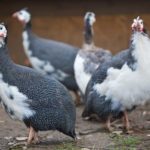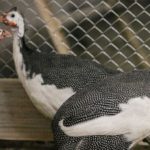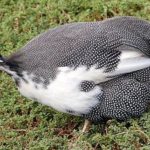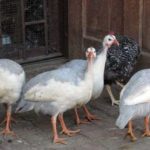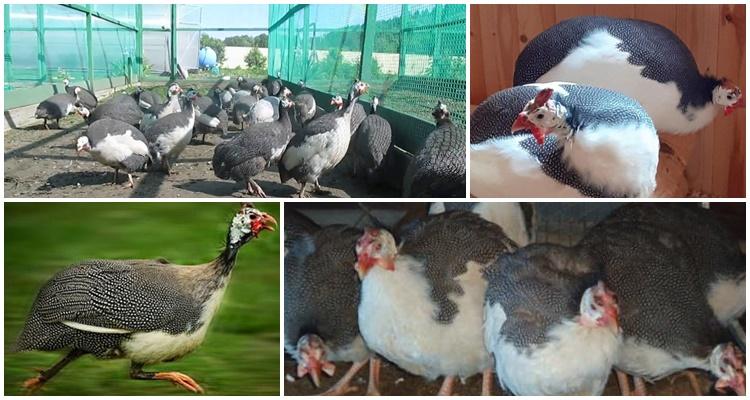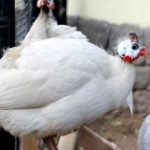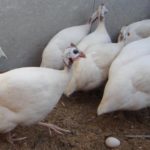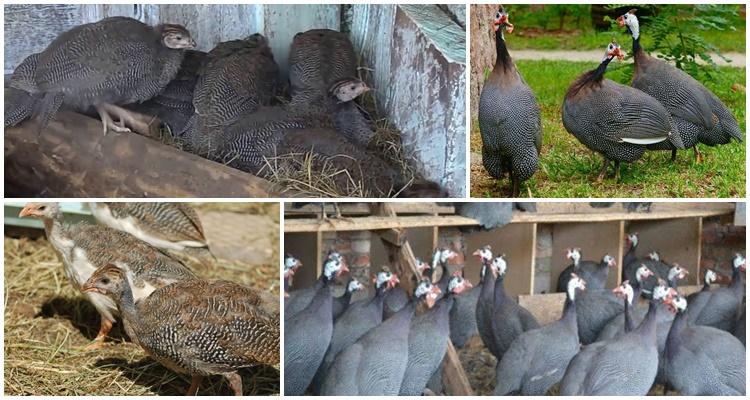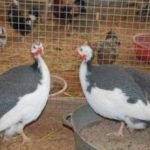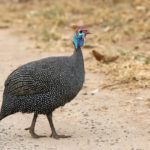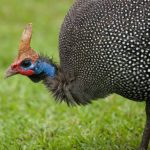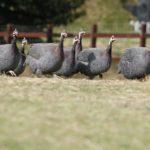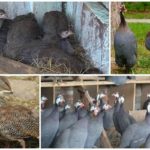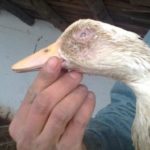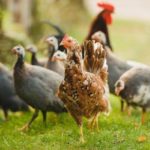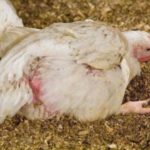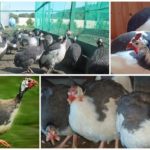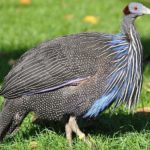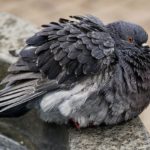Poultry is susceptible to various diseases, most of which are caused by improper care, improper diet and nutrition. Somatic, infectious, and parasitic diseases more often affect guinea fowl with weakened immune systems. In order not to lose livestock, it is necessary to promptly identify sick birds, take measures to solve the problem and protect the inhabitants of the poultry yard.
- Viral and bacterial diseases of birds
- Pullorosis
- Pasteurellosis
- Marek's disease
- Trichomoniasis
- Mycoplasmosis
- Tuberculosis
- Salmonellosis (typhoid, paratyphoid)
- Prevention of infectious diseases
- Non-contagious diseases of guinea fowl
- Gout
- Injuries
- Dyspepsia
- Omphalitis
- Rhinitis
- Yolk peritonitis
- Parasites
- Helminths
- Fleas
Viral and bacterial diseases of birds
Infectious diseases belong to a dangerous group of pathologies. Viruses and bacteria spread to the flock and other animals in the farmstead, and some pose a danger to human health.
Pullorosis
The disease in birds is caused by a type of salmonella. The incubation period usually does not exceed 6 days.
Symptoms of pullorosis:
- hyperthermia (up to 44 °C);
- refusal of food;
- low mobility;
- impaired coordination of movements;
- diarrhea with a white or yellowish coating.
The infection often affects young animals. The death of chicks occurs in the first 10-14 days of illness. Infected guinea fowl must be destroyed. The rest of the livestock are prescribed a course of antibacterial therapy (Sulfadimezin, Biomycin, penicillins).
Pasteurellosis
Pasteurella bacillus penetrates the bird's body mainly through the transdermal route. The bacterium multiplies quickly and spreads through the bloodstream. The outcome of the acute form is the death of the guinea fowl within the next 3 days after contamination. In the case of a chronic course, the bird does not die, but remains infectious.
Signs of the disease:
- apathy, lethargy;
- fever;
- yellow-green diarrhea streaked with blood;
- nasal discharge.
Pasteurellosis is difficult to treat. The rapid development of the disease makes drug therapy not advisable. Infected guinea fowl are sent for slaughter. The disease is dangerous for humans, the carcass is disposed of.
Marek's disease
Marek's disease, or neurolymphomatosis, is caused by a subtype of the herpes virus. The virus manifests itself only after 1-7 months from the moment it enters the cell and irreversibly affects the nervous system, causing paralysis of the wings and legs and neck deformation in guinea fowl. The birds adopt a characteristic split pose.First, several guinea fowls die, then the disease begins to manifest itself in a number of individuals. The virus is excreted in feces and biological fluids, remains viable for a long time, and spreads by airborne droplets.
Trichomoniasis
Trichomonas is a protozoan parasite that enters the body through nutrition. The disease often affects chicks during the first six months of life, causing the death of the brood.
Trichomonas multiplies quickly, causes inflammation of the gastrointestinal mucosa, destroys the walls of blood vessels, causes thrombosis and intoxication. Young animals are acutely ill, while adult guinea fowl are chronically ill. Symptoms of trichomoniasis:
- fever;
- foul-smelling, yellow-gray bubbly stool;
- expansion of the goiter;
- labored breathing;
- discharge from the eyes and nose.
The disease leads to exhaustion of guinea fowls, affecting the gastrointestinal tract. For treatment, drugs of the imidazole group are used.
Mycoplasmosis
Mycoplasma enters the bird's body through airborne droplets and affects internal organs, eyes, and the respiratory system.
Mycoplasmosis in guinea fowl manifests itself:
- difficulty breathing;
- refusal of food and lethargy;
- ruffled plumage;
- sneezing, coughing;
- discharge from the eyes and nose;
- yellow-green diarrhea.
Treatment is effective at an early stage of the disease. Streptomycin antibiotics and macrolides are prescribed.
Tuberculosis
A rare disease among guinea fowl, it occurs in a chronic form. Symptoms that appear several months after infection are mild.
In birds it is noted:
- lethargic behavior;
- yellowness of the skin and mucous membranes;
- crest shrinkage;
- fever;
- movement disorders;
- diarrhea;
- exhaustion.
Anti-tuberculosis drugs and antibiotics are used for therapy. Isoniazid, Pyrazinamide, Rifampicin, Streptomycin, and Ethambutol are prescribed. The first course lasts 60 days, and carriers are fought for up to 4 months.
Salmonellosis (typhoid, paratyphoid)
Salmonella is especially dangerous for chicks, which often become infected during the incubation stage.
Symptoms of salmonellosis:
- depressed state;
- lack of appetite;
- drooping wings and eyelids;
- disheveled;
- inflammation of the mucous membrane of the eyes;
- diarrhea.
Mortality from the acute form reaches 100%. In the chronic form, guinea fowl are given a course of "Furazolidone", then antibiotics of the azithromycin series or "Levomycetin". The third stage is the introduction of nitrofurans. Prophylactic courses of antibiotics are recommended for healthy individuals.
Prevention of infectious diseases
Prevention is the main way to fight infection.
Activities include:
- maintaining optimal temperature, humidity, and cleanliness in the poultry house;
- regular cleaning of feeders and drinkers;
- livestock inspections, isolation of birds with suspected infection;
- separate keeping of adult guinea fowl and chicks;
- balanced diet;
- vaccination.
Regular veterinary control allows you to avoid most problems.
Non-contagious diseases of guinea fowl
In addition to the spread of infections, improper care can cause the development of somatic non-communicable diseases.
Gout
A monotonous diet rich in nitrogen often provokes uric acid metabolism disorders. As a result, its salts are deposited in the joints.
Symptoms of gout:
- deformation and impaired mobility of joints;
- loss of appetite and body weight;
- digestive disorders;
- inflammation of the cloaca;
- whitish droppings.
The birds’ diet is adjusted and given sodium bicarbonate (10 grams per bird) or given “Atophan” at the rate of 0.5 grams per bird. An iodine mesh is made locally and salicylic ointment is rubbed in.
Injuries
If kept improperly, birds injure each other, display aggression and cannibalism.
The reasons are:
- crowdedness;
- intense long-term lighting;
- arid air;
- nutritional deficiencies;
- joint keeping of adults and young animals.
Antiseptic dressings are applied to the wounds, fractures are reduced and fixed with splints or plaster.
Dyspepsia
Dyspepsia is manifested by symptoms of disturbances in the digestive tract: foamy stools, loss of appetite, apathy. More often the syndrome occurs in young chicks. Young animals are given cottage cheese, kefir, vitamins, prebiotics and probiotics, and are switched to balanced feed.
Omphalitis
Inflammation and infection of an unclosed umbilical wound is life-threatening for newborn chicks. The wound becomes inflamed, becomes wet, and requires urgent treatment. The chick is moved into a clean cage, given antibiotics, and the lesion is treated with antibacterial agents.
Rhinitis
Cold and high humidity cause a runny nose in guinea fowl. Birds have difficulty breathing, clear or yellowish mucus is released from the nose, and their appetite worsens. Treatment begins with creating a favorable microclimate in the poultry house, and antimicrobial solutions are instilled into the nostrils.
Yolk peritonitis
The condition, which is fatal for females, is a complication of ovarian rupture. As a result of apoplexy, its contents enter the abdominal cavity, causing an extensive inflammatory process. The bird's belly swells and bald patches form on its body.The female spends most of her time lying down. The cause is early egg laying, injury, and an abundance of fatty foods. The disease is not cured. If you do not allow the female to be slaughtered, the outcome is the death of the bird.
Parasites
In unsanitary conditions, guinea fowl become a target for parasitic attacks. Entomosis, helminthiasis, and arachnoenthomosis apply to all livestock. Birds become weak, grow poorly and become vulnerable to infections.
Helminths
A guinea fowl infected with worms weakens and becomes exhausted in proportion to the growth and reproduction of the parasites. Helminth infections are treated in the early stages. They use Piperazine, Albendazole, Ivermex. In advanced cases, the bird is sent for slaughter.
A rational approach is preventive deworming of the flock.
Fleas
Skin and feather parasites cause discomfort to guinea fowls, reducing productivity. For prevention and treatment, insecticidal agents are used, living conditions are adjusted, and containers with ash are placed for the birds. The best way to protect guinea fowl from diseases is prevention, which includes hygiene and veterinary measures, as well as compliance with the rules of good nutrition.



